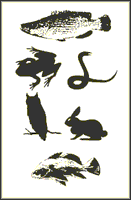Nebraska Cooperative Fish and Wildlife Research Unit

Nebraska Cooperative Fish and Wildlife Research Unit: Staff Publications
Date of this Version
1997
Abstract
Alligator populations in the southeastern United States have substantially recovered since the late 1960s when they were placed on the federal Endangered Species List (Joanen and McNease, 1987). In Florida, both early age class and adult animals currently are harvested for commercial and recreational purposes (Hines and Abercrombie, 1987). In addition, the alligator is ecologically important as a keystone species and as an indicator of wetland health (Mazzotti and Brandt, 1994). Recently, the nonnative ant Solenopsis invicta (the red imported fire ant) has surfaced as a potential threat to alligator populations. Solenopsis invicta is a relatively new (approx. 65 yr) non-indigenous addition to the invertebrate fauna of the United States. Solenopsis invicta is an opportunistic generalist; its main food items are other invertebrates (Wilson and Eads, 1949), but vertebrates also may serve as prey (Allen et al., 1994). Pipping young of oviparous vertebrate species may be especially vulnerable to direct mortality (Allen et al., 1994 and references therein), but indirect effects also are possible (Allen et al., 1995; Guiliano et al., 1996; Pedersen et al., 1996). Indirect effects have been documented for juvenile northern bobwhite (Colinus virginianus), including lower survival rates and body mass gain (Giuliano et al., 1996) and behavioral changes including reduced time spent foraging and resting (Pedersen et al., 1996). Anecdotal reports of S. invicta impacting herpetofauna are plentiful, but published evidence is limited (e.g., Landers et al., 1980; Mount, 1981; Mount et al., 1981; Freed and Neitman, 1988; Donaldson et al., 1994; Montgomery, 1996).


Comments
Published in laurnal of Herpetology, Vol. 31, No.2, pp. 318-321, 1997